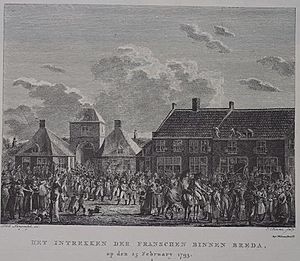Siege of Breda (1793) facts for kids
Quick facts for kids Siege of Breda |
|||||||
|---|---|---|---|---|---|---|---|
| Part of the Flanders Campaign in the War of the First Coalition | |||||||
 French soldiers move into Breda after its capitulation. |
|||||||
|
|||||||
| Belligerents | |||||||
|
|
||||||
| Commanders and leaders | |||||||
| François Joseph Westermann | Alexander of Bylandt | ||||||
| Strength | |||||||
| 3,800 troops 4 mortars 4 howitzers |
1,335 infantrymen 197 dragoons 153 artillerists |
||||||
The Siege of Breda was a short but important battle that happened from February 21 to 27, 1793. It was part of the larger War of the First Coalition, a conflict where several European powers fought against the new French Republic. This siege took place during the Flanders Campaign, which involved battles in what is now Belgium and the Netherlands.
Contents
Why the Siege Happened
After the French Revolution, France was at war with many European countries. In November 1792, the French army, called the Armée du Nord, won a big battle against the Austrians. This victory allowed them to take over the Austrian Netherlands (modern-day Belgium) easily.
French Invasion Plans
The French then decided to invade the Dutch Republic (modern-day Netherlands). They were helped by the Batavian Legion, a group of Dutch people who supported the French Revolution. These Dutch supporters were known as "Patriots."
Breda's Importance
Breda was a very important city because it had a strong fortress. It was also a special place for the House of Orange-Nassau, the ruling family of the Dutch Republic. This made Breda a key target for the French. On February 10, 1793, as French forces got closer, the Dutch leader, William V, Prince of Orange, told his commander, Alexander of Bylandt, to defend Breda no matter what. He said he was willing to sacrifice his own property to protect his country.
The Siege of Breda
The French army crossed the border into the Dutch Republic on February 16. Just two days later, they started putting up "liberty trees" in villages near Breda. These trees were symbols of the French Revolution.
First Attacks and Bombardment
The first fight happened on February 21. After this, about 3,800 French soldiers, led by François Joseph Westermann, blocked all roads leading into Breda. They also began building their siege works, which are structures used to attack a fortress. By February 23, their artillery batteries were ready. The French started firing at Breda with four mortars and four howitzers.
Demands for Surrender
During a break in the fighting, a French officer demanded that the city surrender. But the Dutch defenders refused. So, the French started firing again. Early on February 24, the French fired their last bombs and grenades. They had launched 90 bombs and 100 grenades over the city walls. This destroyed about 60 houses and caused three fires, which were quickly put out. Not many people were hurt on either side.
Breda Surrenders
Even though the French had run out of ammunition, the Dutch defenders didn't know this. When the French officer demanded surrender again, using strong words, the Dutch agreed. They surrendered on the condition that their soldiers could leave with full military honors. The next day, the French took control of one of Breda's gates. On February 27, the French army marched into the city, and the Dutch soldiers marched out.
What Happened Next
The day after Breda surrendered, the French general, Dumouriez, arrived in the city. A liberty tree, topped with a special hat called a Phrygian cap, was placed in front of the town hall. Dumouriez and his officers danced around it, singing the French national anthem, "La Marseillaise." A gallows (a structure for hanging people) was later put next to the tree to help keep order in the city. A new local government, called a Batavian Committee, was set up.
French Retreat and Dutch Return
However, things changed quickly. On March 18, 1793, General Dumouriez suffered a big defeat in the Battle of Neerwinden. Because of this loss, the French commander in Breda started getting the city's defenses ready again. On March 29, a Dutch officer ordered the fortress to surrender in the name of the Prince of Orange. At the same time, Dumouriez sent a letter telling his commander to leave Breda. After a few days of talks, the French gave the city back to the Dutch without another fight.
Breda Changes Hands Again
In September 1794, the French returned to the area. There were some small battles near Breda, and people worried about another siege. But a new siege of Breda didn't happen. Instead, the French attacked other Dutch cities like 's-Hertogenbosch, Grave, and Nijmegen. They crossed frozen rivers and moved quickly through the country. In January 1795, they took over Utrecht and Amsterdam. The Dutch leader, William V, and his family fled to England. On January 18, 1795, the Batavian Republic was declared in Amsterdam, replacing the old Dutch Republic. With this big change, fighting was pointless. Breda surrendered without a fight on January 27, 1795.

